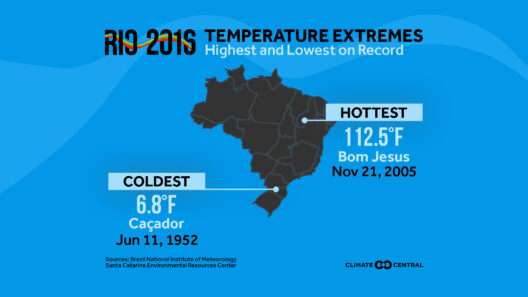In the grand amphitheater of climate, Portugal emerges as a resplendent stage where the Mediterranean warmth oscillates with the cool whispers of the Atlantic breeze. This harmony forges a climate that can be likened to a maestro conducting an intricate symphony—a seamless blend of varied notes that contribute to the country’s overall identity. Intriguingly, Portugal’s geographic location accentuates its climate, creating a tapestry of weather that is both diverse and inviting.
The coastal regions bask in a Mediterranean climate, characterized by balmy summers and mild, albeit slightly damp winters. This maritime influence is like a gentle hand, tempering extremes and fostering a landscape teeming with life. From the sun-kissed shores of the Algarve to the verdant hills of the Douro Valley, the coastal stretches enjoy long days of sunshine with an average of 300 days of sun annually. Here, the summer sun casts a warm embrace, often peaking above 30 degrees Celsius (86 degrees Fahrenheit), inviting tourists to indulge in azure waters and golden sands.
The allure of Portugal’s climate extends beyond mere temperature; it is the precipitation patterns that further embellish this climatic narrative. Most of the rainfall occurs during the winter months, typically from October to April, like a serenade that nurtures the soil and invigorates the vibrant flora. This season brings a refreshing contrast to the arid summer, allowing lush vegetation to flourish across the vineyards and olive groves, painting the landscape with varying shades of green against the backdrop of clear blue skies.
Inland, the climate morphs into a more continental characteristic, demonstrating a less temperate variety. The Alentejo region, for instance, experiences sweltering summers where temperatures can soar well above 35 degrees Celsius (95 degrees Fahrenheit). It is here, amidst rolling plains and cork oak forests, that one can feel the full force of the sun—a radiance that can be both exhilarating and stark. Winter in this part of Portugal, however, is markedly cooler and can even reach zero degrees Celsius (32 degrees Fahrenheit) during the coldest months. This variance adds an exciting dynamic and allows for an agricultural diversity that supports various crops, from wheat to grapes.
The interaction between the Atlantic Ocean and the topography of Portugal creates microclimates that are as varied as Portugal’s rich cultural tapestry. The northwestern region, where the Douro River meets the Atlantic, is notable for its verdant landscape and higher levels of rainfall. This is the birthplace of the famous Port wine, thriving under the meticulous moderation of the Atlantic winds. Here, the vineyards cling to the hillsides, nurtured by the combination of the climate’s humidity and the warmth of the sun—a delicate balance akin to a tightly woven fabric that offers strength yet remains supple.
Conversely, the Algarve, with its sun-bleached cliffs and gentle hills, offers a different climatic temperament. Influenced heavily by the Mediterranean, the region is often touted as basking in the most favorable climate in the world. Mild winters and long, dry summers make it a sanctuary for sun-seekers and horticulturalists alike. The presence of diverse ecosystems, from sandy beaches to rocky coves, creates niches of biodiversity that thrive uniquely within this temperate haven.
Yet, it is important to acknowledge that the climate is not an unchanging entity. The ever-evolving specter of climate change casts a shadow over Portugal’s climatic conditions. As global temperatures rise, the Mediterranean climate bears the brunt of prolonged droughts and erratic weather patterns. Increased temperatures threaten the agricultural practices that have flourished for generations, impacting the very crops that shape Portugal’s identity. The picturesque vineyards and olive orchards, once resilient to minor fluctuations, now face unprecedented challenges.
The sea, once a benevolent guardian, is becoming increasingly volatile. Rising sea levels and changing oceanic conditions threaten coastal habitats, prompting questions about the future of Portugal’s iconic coastline. The interplay of land and sea, which has long been a vital element of Portuguese culture and livelihood, risks being altered irrevocably.
Nevertheless, resilience emerges from this daunting landscape. Portugal stands at the forefront of environmental initiatives, actively fostering sustainability measures that aim to mitigate the impacts of climate change. From transitioning to renewable energy sources to preserving biodiversity, there lies a burgeoning movement fueled by hope and determination. The maturation of this dynamic landscape reflects an understanding that adapting to change is an inherent part of life—much like the climate itself.
In summary, the climate in Portugal is a compelling narrative woven through centuries of interaction with nature. It is a climate painted with Mediterranean hues softened by the caress of the Atlantic winds, a landscape that offers warmth and a bounty of natural beauty. Every season tells a story: the sun-drenched summers promise leisure and exploration, while the nurturing winters bring growth and regeneration. The current patterns and the shadows of climate change serve as both a challenge and an impetus for Portugal—a country determined to thrive amid uncertainties, echoing its historical resilience through time. Thus, as we reflect on this Mediterranean warmth molded by the Atlantic influence, it becomes evident that Portugal’s climate is an intricate dance of elements forever shaping the land and the hearts of its people.








